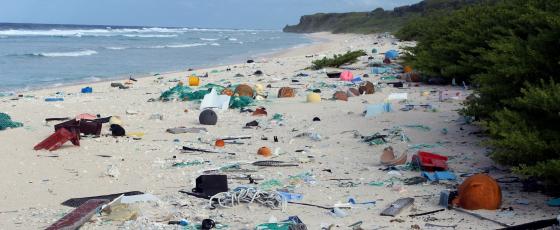Henderson Island is an uninhabited island in the south Pacific Ocean, the largest of the four islands of the Pitcairn Island group and a part of the South Pacific British Overseas Territory. It is also a UNESCO World Heritage Site. UNESCO describes the island as “one of the few atolls in the world whose ecology has been practically untouched by a human presence. Its isolated location provides the ideal context for studying the dynamics of insular evolution and natural selection. ”
Sadly, that description in no longer wholly complete or accurate. It is no longer untouched by humans, nor is it strictly speaking isolated. It lies on the western edge of the South Pacific gyre, a vortex of ocean currents which captures and concentrates floating plastic and trash, at least until the currents wash the plastic onto the beaches of islands like Henderson.
A new study by Dr Jennifer Lavers and Dr. Alexander L. Bond, published in the Proceedings of the National Academy of Sciences, reports that in a 2015 expedition, the researchers documented an estimated 38 million pieces of trash washed up on Henderson’s beaches, amounting to an estimated 17.6 tons of debris on the shores of the tiny island. Dr. Lavers, a research scientist at the University of Tasmania in Australia, told the Australian Broadcasting Corporation that what she saw on Henderson Island was “the highest density of plastic I’ve really seen in the whole of my career.”
Sadly, Henderson Island is not unique. In our post, Choking the Oceans With Plastic, from 2014, we noted that the uninhabited Palmyra Atoll, which lies on the edge of the North Pacific gyre, is also hit by plastic and trash washed ashore by the currents. The beaches are littered with trash and debris. Plastic mooring buoys and plastic bottles are plentiful.
There are five such gyres in oceans around the world. More than 8 million tons of plastic is dumped into our oceans every year.
Thanks to Alaric Bond and David Rye for contributing to this post.


I cant help but wonder how much of this is from when the Japanese had that Tsunami that wiped out several towns. There had to have been plastic trash that came from there. Granted it isnt just from the tsunami’s of Japan.
Apparently, most of the plastic and trash in the Southern Pacific gyre originates in South America, whereas plastics and trash from japan end up in the Northern Pacific gyre.
In 1999 I sailed with my son and a crew bringing a sailboat that had taken part in that year’s TransPac from Hawaii (Kauai) to Port Townsend, Washington. Not a day went by that we didn’t see plastic and a lot of it. That was about 3000 nm (21 days — sailing the whole way) and I was absolutely shocked. It was depressing and frustrating. I don’t think it has gotten any better.